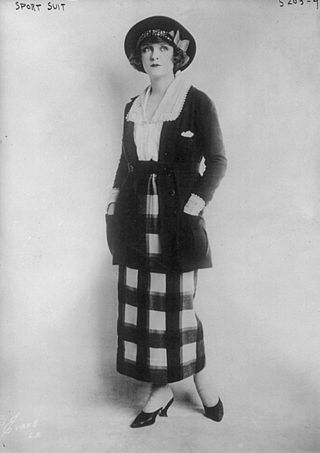
Chester Weinberg (1930-1985) was an American fashion designer. While he was very highly regarded for his design work in the 1960s and early 1970s, he is now mainly known for being the fashion industry's first high-profile AIDS-related death.

Chester Weinberg (1930-1985) was an American fashion designer. While he was very highly regarded for his design work in the 1960s and early 1970s, he is now mainly known for being the fashion industry's first high-profile AIDS-related death.
Chester Weinberg was born in New York on 30 September 1930. [1] He was Jewish. [2]
Weinberg graduated from Parsons in 1951, and between 1955 and 1985 regularly returned to the school as a guest lecturer and visiting critic. [3] He also taught at the Art Institute of Chicago. [1]


After spending the 1950s and early 1960s working for various Seventh Avenue clothing houses, Weinberg launched his own label in 1966, which ran until 1975. [1]
In her 2015 memoir Betty Halbreich remembered Weinberg as being "ahead of his time", as well as designing in suede and with dramatic prints. [4] Weinberg was one of the designers who actively championed the midi skirt in the face of opposition from American buyers and retailers. [5]
By 1970, the year that he won a Coty Award, Chester Weinberg was seen as one of the most important designers on Seventh Avenue, equivalent to Bill Blass or Geoffrey Beene. [6] He gave Bethann Hardison her modelling debut. [7] Despite the hostility of the audience towards Hardison's Blackness, Weinberg was supportive of her and she remembered it as an empowering and groundbreaking experience. [6]
After the closure of his label in 1975, Weinberg worked freelance, creating cashmere knitwear for Ballantyne of Scotland, dress patterns for Butterick and Vogue, and dance costumes for Twyla Tharp's ballet As Time Goes By. [1] In 1978 Weinberg joined Calvin Klein as a consultant, and in 1981 became design director for Calvin Klein Jeans. [3] Weinberg had been one of Klein's heroes as a young designer, and the two men developed a strong friendship and working relationship. [8] Weinberg recruited several design assistants for Klein, including Charles Suppon and Jeffrey Banks who went on to create the Klein logo shirts. [8] [9] [10]
While lecturing at Parsons, Weinberg mentored designers such as Isaac Mizrahi, Marc Jacobs, and Donna Karan. [11] Karan, whose academic record was underwhelming, was accepted into Parsons on Weinberg's recommendation as her mother was his employee. [12]
Chester Weinberg was gay, although until his label closed in 1975, he was firmly closeted and refused to acknowledge his sexuality. [11]
He died of AIDS on 24 April 1985, aged 54, making him the first high-profile fashion designer known to die of the disease. [11] As Weinberg was no longer the household name he had been in the 1960s and early 1970s, the fashion industry actively moved to erase him from history. [11] [13] Until 1990, when Halston publicly acknowledged that he was dying of AIDS, the majority of AIDS-related fashion deaths typically went unacknowledged, or were attributed to other causes in order to protect a designer or brand's reputation and value (the New York Times obituary stated that Weinberg died of encephalitis). [11] [13] Weinberg almost completely disappeared from writings about the fashion industry, the main scholarly acknowledgement of him being a few brief passages in the curator Richard Martin's 1995 encyclopedic work Contemporary Fashion. [11]
Despite the attempts to downplay Weinberg's significance after his death, Calvin Klein placed a full-page memorial in ad space in Women’s Wear Daily, and endowed a Chester A. Weinberg Memorial scholarship fund at Parsons. [11] When the AIDS Quilt was created, Weinberg was included in the panel commemorating Calvin Klein employees. [11]

Donna Karan, also known as DK, is an American fashion designer and the creator of the Donna Karan New York and DKNY clothing labels.

A miniskirt is a skirt with its hemline well above the knees, generally at mid-thigh level, normally no longer than 10 cm (4 in) below the buttocks; and a dress with such a hemline is called a minidress or a miniskirt dress. A micro-miniskirt or microskirt is a miniskirt with its hemline at the upper thigh, at or just below crotch or underwear level.

Calvin Richard Klein is an American fashion designer who launched the company that would later become Calvin Klein Inc., in 1968. In addition to clothing, he also has given his name to a range of perfumes, watches, and jewellery.
Robert Lee Morris is an American jewelry designer and sculptor, who attributes much of his inspiration to organic forms he admires in nature and to designing for an imaginary futuristic society. His designs have been made in gold, silver and bronze and he is known for his 24 carat matte gold plating and rich deep red copper and green patina. He has collaborated or designed collections for fashion designers Geoffrey Beene, Kansai Yamamoto, Calvin Klein, Anne Klein, Karl Lagerfeld, Michael Kors and Donna Karan. Morris was awarded the Coty Award (1981) and the Geoffrey Beene Lifetime Achievement Award by the CFDA Awards (2007).
Michael John Bergin is an American real estate agent and former model and actor.

Heroin chic is a style popularized in early-1990s fashion and characterized by pale skin, dark circles underneath the eyes, emaciated features, androgyny and stringy hair—all traits associated with abuse of heroin or other drugs. American supermodel Gia Carangi is remembered for being the originator of the trend. Heroin chic was partly a reaction against the "healthy" and vibrant look of leading 1980s models such as Cindy Crawford, Elle Macpherson, and Claudia Schiffer. A 1996 article in the Los Angeles Times stated that the fashion industry had "a nihilistic vision of beauty" that was reflective of drug addiction.
Perry Edwin Ellis was an American fashion designer who founded his eponymous sportswear house in the mid-1970s. Ellis' influence on the fashion industry has been called "a huge turning point" because he introduced new patterns and proportions to a market which was dominated by more traditional men's clothing.
Willi Donnell Smith was an American fashion designer. At the time of his death, Smith was regarded as one of the most successful African-American designers in the fashion industry. His company, WilliWear Limited, launched in 1976 and by 1986 grossed over $25 million in sales. After Smith's death, his business partner, Laurie Mallet, continued the line with various designers creating collections. Without Smith, the company floundered and due to financial problems and poor sales, WilliWear Limited ceased production in 1990. WilliWear was the first clothing company to create womenswear and menswear under the same label. The accessibility and affordability of Smith's clothing helped to democratize fashion.
Raf Jan Simons is a Belgian fashion designer. Beginning in furniture design, Simons launched his own menswear label in 1995. He was creative director at Jil Sander (2005–2012), Christian Dior (2012–2015), and Calvin Klein (2016–2018). As of 1 April 2020, he is the co-creative director of Prada, in partnership with Miuccia Prada.

Narciso Jesus Rodriguez III is an American fashion designer.

Fashion in the 1970s was about individuality. In the early 1970s, Vogue proclaimed "There are no rules in the fashion game now" due to overproduction flooding the market with cheap synthetic clothing. Common items included mini skirts, bell-bottoms popularized by hippies, vintage clothing from the 1950s and earlier, and the androgynous glam rock and disco styles that introduced platform shoes, bright colors, glitter, and satin.
Anne Klein was an American fashion designer and businesswoman, the founder and namesake of Anne Klein & Company.

Calvin Klein Inc. is an internationally operating, American fashion house. The company, which became famous for its designer underwear and denim lines in the 1980s, specializes in mass-market ready-to-wear clothing for all genders and age groups as well as leather products, lifestyle accessories and shoes, home furnishings, perfume/cosmetics, eyewear, jewellery and watches in the mid-price segment. Its high-end runway fashion division, which represented the top level of the various Calvin Klein sub-brands, was discontinued in 2019.
The United States is the leading country in the fashion design industry, followed by France, Italy, the United Kingdom, Germany, and Japan. Apart from professional business attire, American fashion is eclectic and predominantly informal. While Americans' diverse cultural roots are reflected in their clothing, particularly those of recent immigrants, cowboy hats, boots, jeans, and leather motorcycle jackets are emblematic of specifically American styles.

Peter Som is a Chinese American fashion designer. He was creative director for Bill Bass and creative consultant for Tommy Hilfiger, where he designed the women’s wear collection, prior to founding his eponymous label. Born and raised in the San Francisco Bay Area, Peter Som graduated from Connecticut College in 1993 with a degree in art history. He continued his studies at the Parsons School of Design where he apprenticed with American designers, Michael Kors and Calvin Klein. At Parsons, his talent was recognized through competitions; he won and was presented with the Parsons Gold Thimble Award by Isaac Mizrahi.

Fern Mallis was the executive director of the Council of Fashion Designers of America (CFDA) from 1991–2001, and created 7th on Sixth productions or New York Fashion Week as it is known today. She was also senior vice president of IMG Fashion from 2001 to 2010. Mallis is currently president of her own international fashion and design consultancy, Fern Mallis LLC. She received her BFA from University at Buffalo.

Sportswear is an American fashion term originally used to describe separates, but which since the 1930s has come to be applied to day and evening fashions of varying degrees of formality that demonstrate a specific relaxed approach to their design, while remaining appropriate for a wide range of social occasions. The term is not necessarily synonymous with activewear, clothing designed specifically for participants in sporting pursuits. Although sports clothing was available from European haute couture houses and "sporty" garments were increasingly worn as everyday or informal wear, the early American sportswear designers were associated with ready-to-wear manufacturers. While most fashions in America in the early 20th century were directly copied from, or influenced heavily by Paris, American sportswear became a home-grown exception to this rule, and could be described as the American Look. Sportswear was designed to be easy to look after, with accessible fastenings that enabled a modern emancipated woman to dress herself without a maid's assistance.
Bethann Hardison is an American fashion model and activist. Hardison is well known for being one of the first high profile black models after her appearance at the 1973 Battle of Versailles fashion show. She is also known for her activism on diversity in the fashion industry. Hardison has received several accolades for her work, including the 2014 CFDA Founders Award. Hardison is the mother of actor Kadeem Hardison.

Richard Georg Willi Puhlmann, was a German fashion photographer, who worked with the top models, stylists and designers in the fashion industry. He was killed when TWA Flight 800 came down shortly after takeoff in 1996.

Charles Suppon (1949-1989) was an American fashion designer.